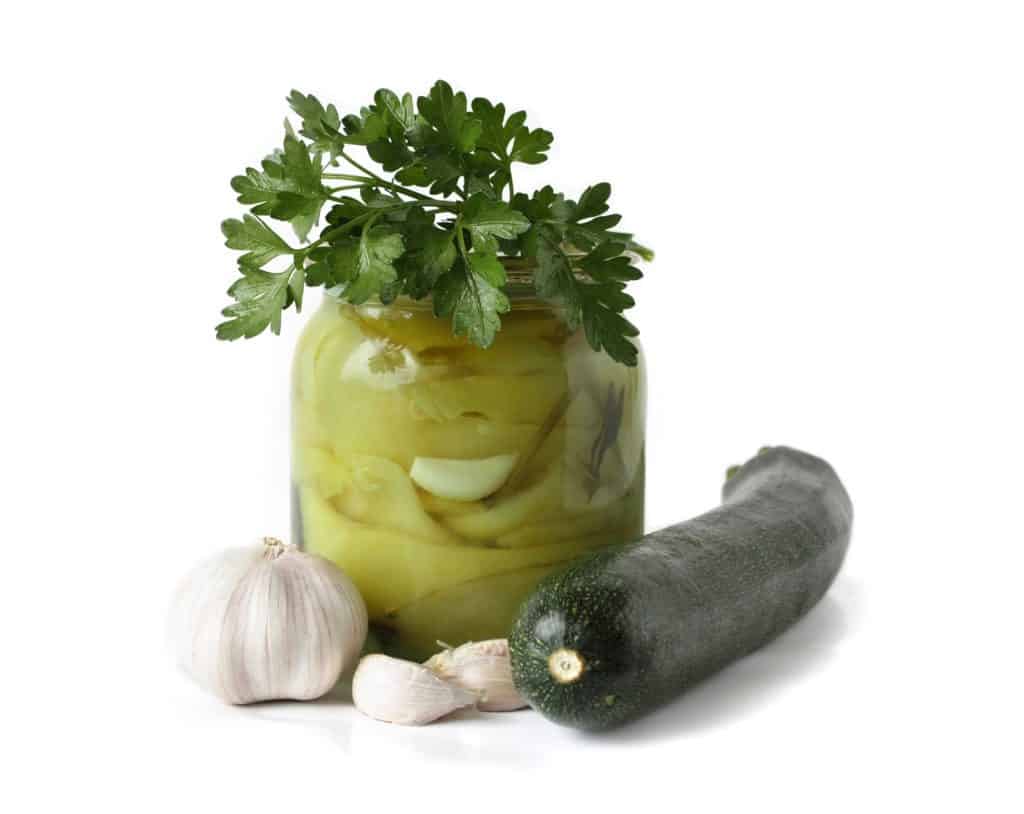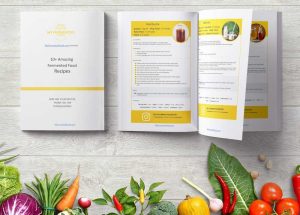
Growing up on a farm it meant that fermented foods were part of our daily diet. For the most part, it included foods such as sauerkraut, yogurt, kefir, sourdough, pickled dill cucumbers and different types of cheeses.
Occasionally mum made fermented pickles such as carrots, cauliflower and zucchini. As a kid, and even now as an adult, I never enjoyed raw or cooked vegetables. However, pickled vegetables is something I could eat anytime. I enjoy the slightly tangy, crunchy and flavorful texture of pickled vegetables.
Recently I’ve made my first batch of pickled zucchini and not to be biased I think they tasted better than my mum’s. They were so delicious that we consumed them within a week.
Homemade zucchini pickles also come with fantastic health benefits like improved digestion and a stronger immune system. My suggestion is to follow the lacto-fermentation method as it retains the nutrients and minerals of the food. The best fermented foods are raw and unpasteurized and are fermented without alcohol or vinegar.
How to make fermented pickled zucchini ?
Making pickled zucchini is simple as you only need two ingredients: fresh zucchini and brine. I personally like using small zucchini, around 4-inch long however, long zucchinis are perfectly fine too. You can cut zucchini into thin spears or smaller rounds.
Brine is simply a mixture of water and salt. Brine is widely used for making other pickles like cucumbers, carrots, onions and others. If you need the brine immediately simple mix a cup of warm water with salt, stir it well until the salt dissolves then add the remaining cool water. You can also make brine in advance and store it in a glass jar with an airtight lid in the refrigerator.
If you need help making brine use my BRINE CALCULATOR to get the right salt to water ratio.
After cutting zucchini and making the brine, start packing the zucchini into the glass jar then pour the brine in. Ensure to leave around 1-inch from the top of the jar and ensure that zucchini are sitting below the brine. If you don’t have enough brine, you can make some more. Otherwise, you will need to shake the jar on a daily basis to stop the mold forming at the top of the zucchini.
Ensure to seal the jar but leave it loose enough for the gasses that bubble up inside the jar to escape. Otherwise, you will have an overflowing jar.
If you like to experiment, you can add different herbs and spices like black peppercorns, mustard seeds, onion, garlic, dill and others. These condiments will create a different texture and add aroma to your fermented zucchini pickles.

What to avoid when making zucchini pickles?
You may come across other recipes which suggest the use of sugar and vinegar. I generally avoid adding sugar to any sour food I make, as I like to taste the real food and don’t like the fact that sugar takes away the real flavor and texture of the food. Vinegar is commonly added to the brine and used for making canned foods. It is a preservative which stops natural fermentation from occurring and removes probiotic benefits of fermented foods.
Ensure to use filtered or purified water for your brine instead of tap water. Avoid using tap water because it will inhibit fermentation. If the tap water is all you have, you can make it chlorine free by boiling it, then letting it cool down at room temperature before making the brine.
Pure unrefined sea salt, kosher salt or pink Himalayan salt is the best type to use not just for zucchini but all of your ferments. Chemicals added to the table salt can cause an issue with fermentation.
What to expect when making pickled zucchini?
Zucchinis usually take 3-7 days to ferment depending on the type of zucchini, the brine and general storage conditions. After 2-3 days you will notice that brine starts to get cloudy. Do not panic, as this is expected.
After the third day, start tasting your pickled zucchini. Once the desired flavor is achieved move them into a refrigerator and store them up to a month.
Serve zucchini pickles with your favorite burger or sandwich.

Pickled Zucchini Recipe
- Total Time: 30 minutes
Description
These homemade fermented zucchini pickles are flavorful, crunchy and super easy to make.
Ingredients
- 4 cups of zucchini thinly sliced into rounds
- ¼ red onion thinly sliced
- 3 garlic cloves peeled and halved
- 2 teaspoons of grated ginger
- 4 cups of filtered water
- 2 tablespoons of sea salt
Instructions
- Wash zucchini, trim them on both ends then slice them into even rounds.
- Pack zucchini into the glass jar.
- Add red onion, garlic and ginger.
- Make the brine by mixing ½ cup of warm water with the salt and stir until the salt has dissolved then add the remaining water.
- Pour the brine into the jar with zucchini leaving space of 1-inch at the top of the jar. The zucchinis should be submerged below the brine. If not, make more brine and pour it in.
- Cover the jar loosely with a lid and store in a cool and dry place without direct sunlight for 3-7 days.
- The brine will start to get cloudy after a couple of days. Don’t worry, this is expected.
- Start tasting the pickled zucchini after the third day. It should start getting sour and smell like pickles.
- Once the desired taste is achieved store the zucchini in the refrigerator for up to a month.
Notes
Equipment: 2-quart glass jar with lid
- Prep Time: 30 minutes
Nutrition
- Serving Size: 100 grams
- Calories: 37
- Sugar: 6.37 grams
- Sodium: 168 mg
- Fat: 0.24 grams
- Carbohydrates: 8.57 grams
- Fiber: 1.1 gram
- Protein: 1.05 grams
- Cholesterol: 0 mg
Related posts
The Best Homemade Dill Pickles Recipe

Leave a Reply